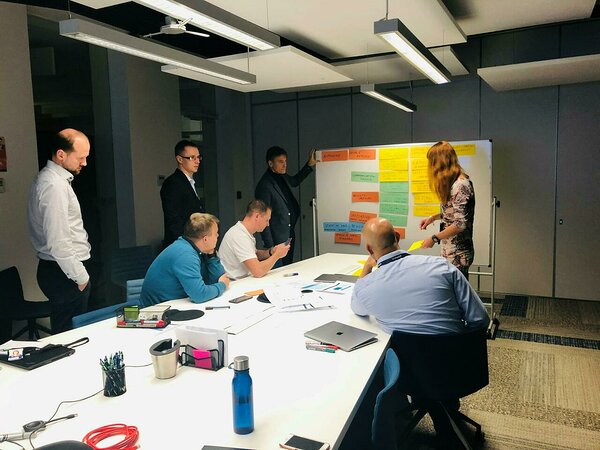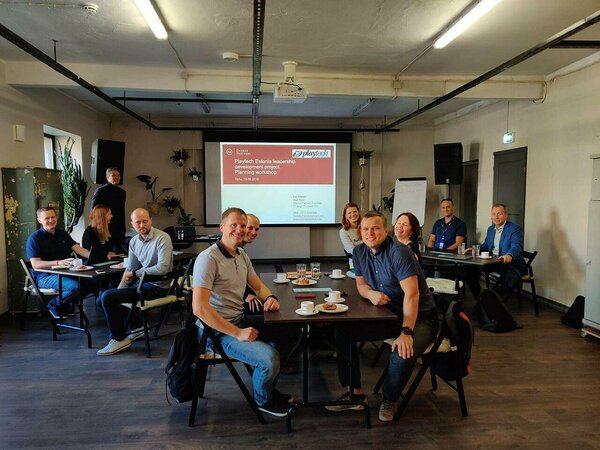At Playtech, we strongly believe that our people leaders play a vital role in building organizational culture and employee engagement and that this leads to business success as well. After all, our people have been the key to our success and achievements throughout the years. So, one of the most important questions for us as the HR team has inevitably been: how can we support our leaders in their growth?
Although I am a true believer of learning-by-doing and other ways of learning, this article focuses on our experience in designing an effective development program. Sometimes this is just what you need to take the next step in boosting managerial quality.
Our Challenge: How to Find a Unified Approach?
As a huge international company, our structure relies on business units that operate independently across countries. We have seven big units (some partially) in Estonia, being very different in their nature and background, representing various leadership styles, multiple needs and unsimilar motivations to contribute to leadership skills development from their senior managers.
Hence, our challenge mostly addressed the heterogeneity of our organizational setup, but as we strongly believe that the essence of the people leader role is the same across units, we just needed to find a mutual ground to set the focus on. So, we agreed that our focus needs to be on growing leadership competencies and unifying our leadership practices.
To describe the group of managers we are talking about, we have 90 managers in Estonia – 6 business unit managers, 26 middle level managers and 58 team leads. Their experience varies from less than a year to tens of years of experience as a people leader. Around 90% of them have moved from a specialist’s role to a manager’s role within their working time at Playtech, having no prior experience in people management.
Step 1: Setting the Expectations
To begin this journey of a thousand miles, we gathered the senior managers and asked them a quite simple question – what do they expect from the people leaders that lead different teams in their business unit? Surprisingly, it was not hard to agree on 10 key aspects. These started with having a clear vision and purpose for the team, creating a culture of initiative and ownership, making sure that communication is effective, building strong relationships and ended with continuous development and getting things done.
We at Playtech have always been believers of involvement, so we knew that just agreeing on the aspects does not mean we are there yet. Therefore, as the next step, we involved almost all of our team leads in the discussions to understand what those expectations mean in their everyday work, what they are strong at and where they see room for improvement.
These discussions gave us a clear understanding where our development activities need to be directed – this was mainly effective communication and empowering people: the why? and how? of strategic communication, managing employee expectations, delivering complicated messages, building strong relationships and creating trust inside teams, supporting development through coaching and many other topics.
Step 2: What’s the Best Plan Towards Better Leadership Skills?
As our needs were clearly defined on all levels of leadership, the only way forward was to design development programs specially for Playtech managers. We eventually decided to combine business unit managers and middle level managers into one group, but kept the team leaders separately. The focuses differed somewhat, and we wanted to start with higher levels, so they would become the support front for their team leads later on.
We were about to kick off the program in spring but then we all know what happened. Certainly this gave us pause – is a global crisis the right time for developing our managers’ skills? But then again – why not? Isn’t this the moment when your managers need the most support?
For us, the decision to start during the pandemic created a whole new challenge – can the program be done virtually? Our chosen partner ChangePartners assured that it is doable just as well as in a classroom, considering the technical tools available to us (Zoom breakout groups, polls, etc). We were skeptical but ready to try as we thought that if the managers need to be able use the new skills virtually, then it should be possible to learn the skills online as well.
Going straight to the conclusion, I must say the format worked well. It even inspired us to create Playtech’s first-ever global development program for new managers, bringing all the new people leads from different countries together. In Estonia, we held 38 sessions (equal to 86 hours of training time) over a 10-month period for three groups of managers.
Tips to Design a Leadership Development Program Virtually
First, you need to be one step ahead of the managers to know what they need – whether it’s the change in their mindset, new skills or leadership tools. Nothing helps more than a great partner who tries to understand your needs but has a strong backbone to also tell you if the requirements you want to set are not the wisest. Our recommendation is to choose the best of the best – this partner might cost more but you have limited time, and you need to take the maximum out of it.
Second, you require attention from your participants – never underestimate this. You need the participants to be interested enough to show up and actively participate. Avoid the following traps:
- Assuming that everyone will be motivated to participate. No, you have to sell the idea and motivate them to make space for learning. Have a kick-off session with everyone or find some other way to explain what to expect and what’s in it for the managers. You cannot forcibly develop someone, but you can create the right conditions for it and provide the tools.
- Letting managers of the participating managers take a bystander role. Instead, make sure that people leading the program participants are onboard and support your aspirations. After all, they are the ones who can prioritize the program above other operational tasks and whose interest in development is what creates motivation for the participants as well.
- Having participants bored to death. To avoid that, design the training sessions be so interesting and interactive that they are not able to do anything else in parallel even if they are the best multitaskers.
- Making it too easy to stay behind, skip sessions and run out of motivation. To not let them lose track, it’s a good idea to record the training sessions, so no one would have the feeling they cannot attend the next session when they had to skip the previous one.
Of course, we did not end up having full participation from all who were invited but we made sure everyone knew what the program is about and those that attended took a lot of value out of it.
After the Program: Reactions and Follow-Up Activities
We all know you can never please everyone with one unified program, so expect to receive feedback from as many different angles as you can imagine. Some leaders love the trainer, others not so much. Some want it to be more active, others want to hear more about the experiences of the facilitator. Some feel that they need more time to digest the new information, others feel that it is all going too slow. It is important to listen, analyze and not jump to conclusions but to really try to understand which piece of feedback is the one to consider and implement.
However, the biggest challenge does not lie in analyzing feedback. Instead, it is putting the newly acquired knowledge and skills into action. How to create the time and space for continuous practicing? No-one else can do it other than the participant themself, so it is mostly about internal motivation.
You can try to make an impact with regular homework and peer pressure (e.g discussions on the learnings and first attempts in trying out newly acquired techniques in real life) but in the end, it’s mostly related to self-awareness and understanding of why or what’s in it for me. As our trainer Toomas Tamsar nicely said, “Most leaders in companies do not need too much new knowledge but they need to take the knowledge they have somewhere and start practicing. Knowing is not equal to doing.”
From the program: How a great leader is described?
The biggest victory moment of the whole process for us as designers of the program was seeing the “heureka” moments on the screen when, after practicing, someone discovered the impact of a newly learnt tool or we could detect a clear shift in another manager's head. One could not expect a better feedback to their work done.
These have been our first steps on a thousand step journey. Are we close to the finish line? No, far from it. I like what one of our managers said as a summary of the whole leadership skills development training program, “I found out how much better everything can be done”. This is music to our ears as raising awareness was one of our main goals.
There is a lot more room for professional growth, but you have to be smart enough to celebrate the small wins along the way. This is what we aimed to achieve within our first steps and efforts, and what we will keep working on in our planned follow-up activities to support our leaders in their development.



_block.png)